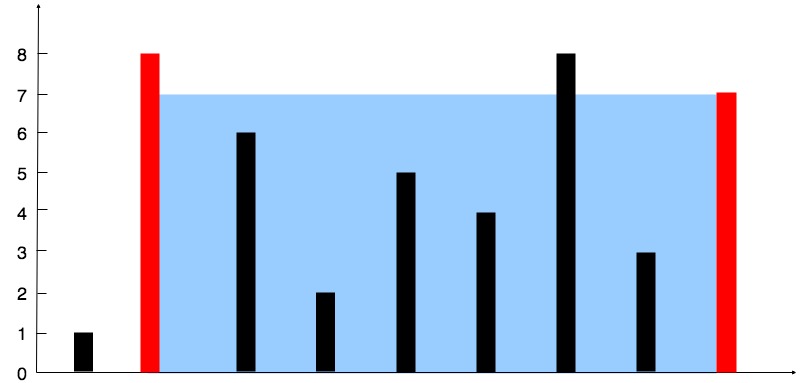You are given an integer array height of length n. There are n vertical lines drawn such that the two endpoints of the ith line are (i, 0) and (i, height[i]).
Find two lines that together with the x-axis form a container, such that the container contains the most water.
Return the maximum amount of water a container can store.
Notice that you may not slant the container.
Example 1:
Input: height = [1,8,6,2,5,4,8,3,7]
Output: 49
Explanation: The above vertical lines are represented by array [1,8,6,2,5,4,8,3,7]. In this case, the max area of water (blue section) the container can contain is 49.
Example 2:
Input: height = [1,1]
Output: 1
Constraints:
n == height.length2 <= n <= 1050 <= height[i] <= 104
給定一個非負整數陣列 height
其中每個 height[i] 代表 index i 的格版高度
假設 每兩個 height 之間相隔為單位 1
往中間注水 假設格版本身很薄 所以不計
則兩個 height 所能裝的水的面積 剛好是由比較小的 height * 兩個 height 的 X軸相查距離 = min(height[i], height[j]) *(j -i) if i < j
要求寫一個演算法來計算再給定的 height 中所能注入最多面積是多少
由於每個面積都是由兩個 height 來圍出
所以可以透過 two pointer 然後逐步更新最短的 height 的 point 來找尋下一個更多面積的可能值
直到兩個 height 只差 1
而再這之間不斷把當下最大的做紀錄
初始化 lp =0, rp = len(height), maxArea = 0
當 lp < rp 做以下運算
area = min(height[lp], height[rp]) *(rp-lp)
如果 area > maxArea, 則更新 更新 maxArea = area
如果 height[lp] > height[rp], 更新 rp -= 1 否則更新 lp += 1
package sol
func maxArea(height []int) int {
mArea := 0
lp, rp := 0, len(height)-1
var min = func(a, b int) int {
if a < b {
return a
}
return b
}
for lp < rp {
area := min(height[lp], height[rp]) * (rp - lp)
if mArea < area {
mArea = area
}
if height[lp] > height[rp] {
rp--
} else {
lp++
}
}
return mArea
}- 要看出與面積相關的計算方式
- 要看出如何找下一個可能的更大的面積
- 初始化 rp =0, lp = len(height) - 1, maxArea = 0
- 當 rp < lp 做以下運算
- area = min(height[lp], height[rp]) *(rp-lp)
- if area > maxArea 更新 maxArea = area
- 當 height[lp] > height[rp] 更新 rp -= 1 否則更新 lp += 1
- 回傳 maxArea


